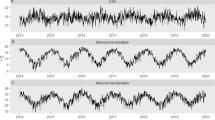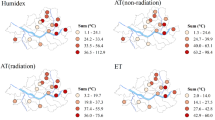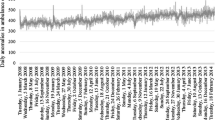Abstract
Heatwaves can be a common occurrence in Australia, and the public health impacts can be severe. Heat warnings and interventions are being adopted widely to reduce the preventable health impacts. This study examines the effects of heatwaves on morbidity and mortality in different climatic regions in the state of South Australia, to inform the targeting of heat warnings according to regional needs. Heatwaves were defined using the excess heat factor (EHF), an index based on mean daily temperature indices that quantifies heatwave severity relative to the local climate. In all regions, there were increases in morbidity (daily rates of ambulance call-outs and heat-related emergency presentations and hospital admissions) on heatwave days compared to non-heatwave days, which increased with heatwave severity. This study demonstrates that a consistent measure for heatwave severity, based on EHF, can be used to underpin public health warnings for climatically diverse areas.

Similar content being viewed by others
References
Akompab DA, Bi P, Williams S, Saniotis A, Walker I, Augoustinos M (2013) Engaging stakeholders in an adaptation process: governance and institutional arrangements in heat-health policy development in Adelaide, Australia. Mitig Adapt Strategies Glob Chang 18:1001–1018
Australian Bureau of Statistics. (2008) ABS releases measures of socio-economic advantage and disadvantage. http://wwwabsgovau/AUSSTATS/abs@nsf/Previousproducts/2033055001Media%20Release22006?opendocument&tabname=Summary&prodno=2033055001&issue=2006&num=&view= Accessed 6 May 2013
Australian Bureau of Statistics (2016). Regional population growth, Australia, 2016 http://wwwabsgovau/ausstats/abs@nsf/Latestproducts/32180Main%20Features752016?opendocument&tabname=Summary&prodno=32180&issue=2016&num=&view= Accessed 5 February 2018
Australian Government Bureau of Meteorology (2017) South Australia forecast area map. http://www.bom.gov.au/sa/forecasts/map.shtml Accessed 2 May 2017
Australian Government Bureau of Meteorology. (2015) Climate change and variability. http://wwwbomgovau/climate/change/indexshtml#tabs=Tracker&tracker=timeseries&tQ[graph]=tmean&tQ[area]=sa&tQ[season]=0112&tQ[ave_yr]=10 Accessed 24 May 2017
Azhar GS, Mavalankar D, Nori-Sarma A, Rajiva A, Dutta P, Jaiswal A, Sheffield P, Knowlton K, Hess JJ, on behalf of the Ahmedabad HeatClimate Study Group (2014) Heat-related mortality in India: excess all-cause mortality associated with the 2010 Ahmedabad heat wave. PLoS One 9(3):e91831. https://doi.org/10.1371/journal.pone.0091831
Bassil KL, Cole DC (2010) Effectiveness of public health interventions in reducing morbidity and mortality during heat episodes: a structured review. Int J Environ Res Public Health 7(3):991–1001
Ebi KL, Teisberg TJ, Kalkstein LS, Robinson L, Weiher RF (2004) Heat watch/warning systems save lives: estimated costs and benefits for Philadelphia 1995-98. Bull Am Meteorol Soc 85:1067–1073
Eckert KA, Taylor AW, Wilkinson D (2004) Does health service utilisation vary by remoteness? South Australian population data and the accessibility and remoteness index of Australia. Aust N Z J Public Health 28(5):426–432
Faunt JD, Wilkinson TJ, Aplin P, Henschke P, Webb M, Penhall RK (1995) The effete in the heat: heat-related hospital presentations during a ten day heat wave. Aust NZ J Med 25(2):117–121
Griffin T, McCaskill M. (1986) Atlas of South Australia. http://wwwatlassagovau/resources/atlas-of-south-australia-1986/environment-resources/climate-and-weather Accessed 7 May 2013
Harlan SL, Declet-Barreto JH, Stefanov WL, Petitti DB (2013) Neighborhood effects on heat deaths: social and environmental predictors of vulnerability in Maricopa County, Arizona. Environ Health Perspect 121(2):197–204
Hattis D, Ogneva-Himmelberger Y, Ratick S (2012) The spatial variability of heat-related mortality in Massachusetts. Appl Geogr 33:45–52
Hatvani-Kovacs G, Belusko M, Pockett J, Boland J (2016) Can the excess heat factor indicate heatwave-related morbidity? A case study in Adelaide, South Australia. EcoHealth 13(1):100–110
Henderson SB, Wan V, Kosatsky T (2013) Differences in heat-related mortality across four ecological regions with diverse urban, rural, and remote populations in British Columbia. Canada, Health & Place. https://doi.org/10.1016/j.healthplace.2013.1004.1005
Jegasothy E, McGuire R, Nairn J, Fawcett R, Scalley B (2017) Extreme climatic conditions and health service utilisation across rural and metropolitan New South Wales. Int J Biometeorol 61:1359–1370. https://doi.org/10.1007/s00484-00017-01313-00485
Jones DA, Wang W, Fawcett R (2009) High-quality spatial climate data-sets for Australia. Aust Meteorol Ocean 58(4):233–248
Jones R, Tonts M (2003) Transition and diversity in rural housing provision: the case of Narrogin, Western Australia. Aust Geogr 34(1):47–59
Kenny GP, Yardley J, Brown C, Sigal RJ, Jay O (2010) Heat stress in older individuals and patients with common chronic diseases. CMAJ 182(10):1053–1060
Kjellstrom T, Holmer I, Lemke B (2009) Workplace heat stress, health and productivity—an increasing challenge for low and middle income countries during climate change. Glob Health Action 2:2047. https://doi.org/10.3402/gha.v210.2047
Kovach MM, Konrad CE, Fuhrmann CM (2015) Area-level risk factors for heat-related illness in rural and urban locations across North Carolina, USA. Appl Geogr 60:175–183
Kovats RS, Hajat S (2008) Heat stress and public health: a critical review. Annu Rev Public Health 29:41–55
Langlois N, Herbst J, Mason K, Nairn J, Byard RW (2013) Using the excess heat factor (EHF) to predict the risk of heat related deaths. J Forensic Legal Med 20(5):408–411
Lippmann SJ, Fuhrmann CM, Waller AE, Richardson DB (2013) Ambient temperature and emergency department visits for heat-related illness in North Carolina, 2007–2008. Environ Res 124:35–42. https://doi.org/10.1016/j.envres.2013.1003.1009i
Loughnan M, Nicholls N, Tapper N (2010) Mortality–temperature thresholds for ten major population centres in rural Victoria, Australia. Health & Place 16:1287–1290
McGeehin MA, Mirabelli MC (2001) The potential impacts of climate variability and change on temperature-related morbidity and mortality in the United States. Environ Health Perspect 109(Suppl 2):185–189
Nairn J, Fawcett R, Ray D (2009). Defining and predicting excessive heat events, a national system. Modelling and understanding high impact weather: extended abstracts of the third CAWCR Modelling workshop, Citeseer
Nairn JR, Fawcett RJ (2015) The excess heat factor: a metric for heatwave intensity and its use in classifying heatwave severity. Int J Environ Res Public Health 12(1):227–253
National Rural Health Alliance Inc. Fact Sheet 23: Measuring the metropolitan-rural inequity. 2010. Available online: http://nrha.ruralhealth.org.au/factsheets/?IntContId=14819&IntCatId=41 Accessed on: 5 February 2018
Nitschke M, Tucker G, Hansen A, Williams S, Zhang Y, Bi P (2016) Evaluation of a heat warning system in Adelaide, South Australia, using case-series analysis. BMJ Open 6(7):e012125. https://doi.org/10.1136/bmjopen-2016-012125
Nitschke M, Tucker GR, Hansen AL, Williams S, Zhang Y, Bi P (2011) Impact of two recent extreme heat episodes on morbidity and mortality in Adelaide, South Australia: a case-series analysis. Environ Health 10. https://doi.org/10.1186/1476-1069X-1110-1142
Robine J-M, Cheung SLK, Le Roy S, Van Oyen H, Griffiths C, Michel J-P, Herrmann FR (2008) Death toll exceeded 70,000 in Europe during the summer of 2003. C R Biologies 331:171–178. https://doi.org/10.1016/j.crvi.2007.12.001
Scalley BD, Spicer T, Jian L, Xiao J, Nairn J, Robertson A, Weeramanthri T (2015) Responding to heatwave intensity: excess heat factor is a superior predictor of health service utilisation and a trigger for heatwave plans. Aust N Z J Public Health 39:582–587. https://doi.org/10.1111/1753-6405.12421
Semenza JC, Rubin CH, Falter KH, Selanikio JD, Flanders WD, Howe HL, Wilhelm JL (1996) Heat-related deaths during the July 1995 heat wave in Chicago. N Engl J Med 335(2):84–90
Shaposhnikov D, Revich B, Bellander T, Bedada GB, Bottai M, Kharkova T, Kvasha E, Lezina E, Lind T, Semutnikova E, Pershagen G (2014) Mortality related to air pollution with the Moscow heat wave and wildfire of 2010. Epidemiology 25:359–364. https://doi.org/10.1097/EDE.0000000000000090
Sheridan SC, Dolney TJ (2003) Heat, mortality, and level of urbanization: measuring vulnerability across Ohio. USA Climate Res 24:255–265
State Coroner (2010) Annual report of the state coroner financial year 2009–2010. South Australia
Toloo G, FitzGerald G, Aitken P, Verrall K, Tong S (2013) Evaluating the effectiveness of heat warning systems: systematic review of epidemiological evidence. Int J Public Health 58(5):667–681
Victorian Chief Health Officer (2009). January 2009 Heatwave in Victoria: an assessment of health impacts Melbourne, Victorian Government Department of Human Services
Williams S, Bi P, Newbury J, Robinson G, Pisaniello D, Saniotis A, Hansen A (2013) Extreme heat and health: perspectives from health service providers in rural and remote communities in South Australia. Int J Environ Res Public Health 10(11):5565–5583
World Meteorological Organization and World Health Organization (2015). Heatwaves and health: guidance on warning-system development. WMO-No. 1142. G. R. McGregor
Wu P-C, Lin C-Y, Lung S-C, Guo H-R, Chou C-H, Su H-J (2011) Cardiovascular mortality during heat and cold events: determinants of regional vulnerability in Taiwan. Occup Environ Med 68(7):525–530
Xiao J, Spicer T, Jian L, Yun GY, Shao C, Nairn J, Fawcett RJB, Robertson A, Weeramanthri TS (2017) Variation in population vulnerability to heat wave in Western Australia. Front Public Health 5. https://doi.org/10.3389/fpubh.2017.00064
Zhang Y, Nitschke M, Krackowizer A, Dear K, Pisaniello D, Weinstein P, Tucker G, Shakib S, Bi P (2016a) Risk factors for deaths during the 2009 heat wave in Adelaide, Australia: a matched case-control study. Int J Biometeorol 61:35–47
Zhang Y, Nitschke M, Krackowizer A, Dear K, Pisaniello D, Weinstein P, Tucker G, Shakib S, Bi P (2016b) Risk factors of direct heat-related hospital admissions during the 2009 heatwave in Adelaide, Australia: a matched case-control study. BMJ Open 6(6):e010666. https://doi.org/10.1136/bmjopen-2015-010666
Acknowledgements and funding
The authors would like to acknowledge the contributions of Mr. Graeme Tucker to the design of this study.
This study was supported by the Attorney General’s Department of the Australian Government, under the National Emergency Management Projects Scheme [grant number NP1617-017].
Author information
Authors and Affiliations
Corresponding author
Ethics declarations
Ethics approval was obtained from the Human Research Ethics Committees of The University of Adelaide and SA Health.
Conflict of interest
The authors declare that they have no conflict of interest.
Appendices
Appendix 1
Appendix 2
Results from a sensitivity analysis using alternative regional sites for meteorological observations
Rights and permissions
About this article
Cite this article
Williams, S., Venugopal, K., Nitschke, M. et al. Regional morbidity and mortality during heatwaves in South Australia. Int J Biometeorol 62, 1911–1926 (2018). https://doi.org/10.1007/s00484-018-1593-4
Received:
Revised:
Accepted:
Published:
Issue Date:
DOI: https://doi.org/10.1007/s00484-018-1593-4





